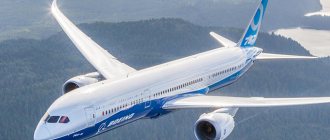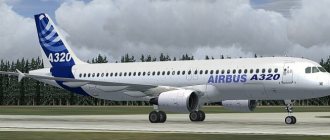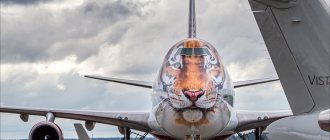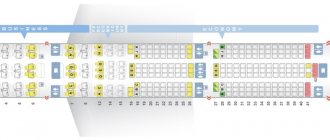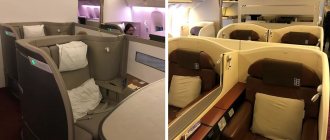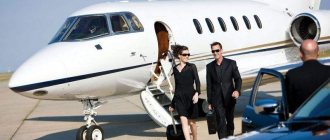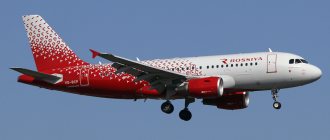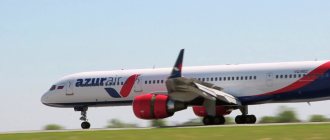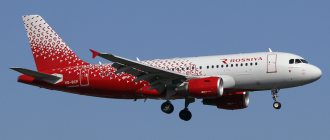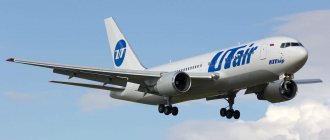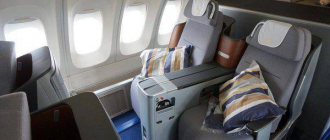Characteristics and seat layout of the Boeing 737-200
The Boeing 737-200 aircraft, with a maximum flight range of 3,500 km, has a cruising speed of 817 km/h. Maximum speed – 876 km/h. Fuselage length – 30.5 m, height – 11.2 m, width – 3.7 m.
The aircraft manufacturer produced Boeing 737-200 with one economy class cabin layout for 130 people and a two-class cabin layout for 102 passengers. The cabin width is 3.5 m. It is equipped with an air conditioning system with two channels, a primary power supply system and an analogue avionics complex with electromechanical induction.
737-200 interior layout
Operating companies
Boeing 737 is operated by global airlines in 115 countries. The largest number of aircraft of this type belong to air carriers:
| Company | Number of aircraft, pcs. |
| Southwest Airlines (USA) | 684 |
| Ryanair (Ireland) | 297 |
| United Airlines (USA) | 265 |
| American Airlines (USA) | 244 |
| Delta Air Lines (USA) | 101 |
The aircraft is used for both transcontinental flights and ultra-short flights. This is the main airliner for flights to Alaska, the northern regions of Canada, and the Pacific Islands.
Interesting! The shortest route operated by a Boeing 737 is 14 km. Transportation is carried out by the Japanese Japan TransOcean Air between two islands in the Pacific Ocean (Minami Daito - Kita Daito). Air Tanzania operates flights from Dar es Salaam to Zanzibar Island (65 km).
Where is the best place to sit on a plane?
The Boeing 737-200 airliner has a small passenger cabin, designed to carry 102-130 people. Standard pitch of space between passenger seats. Small aisles in the rows. There are places of increased comfort, characterized by increased legroom. To determine their location in the aircraft cabin, we suggest studying the layout of the passenger Boeing 737-200 with a two-class cabin layout for 107 seats.
Features of the seats in the cabin:
- Rows 1-3 – business class cabin. The seats are arranged in two rows in a 2x2 layout. Passenger capacity – 12 people. A large aisle between the rows and a wide pitch of space between the seats in a row creates comfortable conditions for passengers to fly. Passengers in the first row may feel some discomfort, due to the proximity of the location to toilet rooms and technical rooms. During an overnight flight, the aisle lights that cannot be turned off can be distracting. And in the third row of business class, passengers may experience inconvenience due to noise coming from economy class, located immediately behind the partition. We also suggest that you familiarize yourself with how to choose the right comfortable seat in the aircraft cabin.
- From rows 10 to 25 – economy class of service. The seats are arranged in two rows in a 3x3x pattern. The cabin capacity is 95 (96) people. The 10th row seats with increased legroom are considered the most comfortable.
- Between rows 14-15-16 there are emergency hatches. Passengers with children, pets, minor travelers, pregnant women, disabled people and pensioners cannot occupy seats here.
- The 14th row seats have a locked backrest lowering mechanism. Inconvenient places to fly.
- The most uncomfortable seats are those installed in the last 25th row of the economy class. They are located next to the toilet, so during the flight passengers may be distracted by other travelers moving around the cabin to the restroom and noisy queues forming outside the door. In addition, the seats in this row are motionless (the backrest does not recline).
Each airline's aircraft may have different seating arrangements, depending on the layout chosen. When planning a flight on a Boeing 737-200, study in advance the cabin layout of the specific aircraft operated by the selected airline.
Articles about other airliners with interior diagrams:
Description and cabin diagram of the CRJ-1000 Boeing 777 airliner - review, modifications and characteristics, cabin layout of the Sukhoi Superjet 100 - characteristics and best seats on the Airbus A320 aircraft - review, cabin layout, where is the best place to sit Review and layout of the Boeing 737 MAX 8 passenger cabin Description and diagram of the Airbus A319 passenger airliner Review of the Airbus A330 aircraft: characteristics, cabin layout, best seats Review and diagram of the Airbus A300 passenger airliner How to choose a free comfortable seat in the aircraft cabin
Content
- 1 Development and Design 1.1 Background
- 1.2 Model development
- 1.3 Engines
- 1.4 Speed cutting system
- 1.5 Further developments
- 1.6 Modifications
- 2,1 737-300
- 3.1 Civil
Which airlines operate the Boeing 737-200
Today, the Boeing 737-200 aircraft is operated by about 30 global air carriers. The outdated model is mainly used by companies in developing countries, primarily African ones. Most of the world's major carriers have replaced this model with improved versions of the Boeing with an increased flight range and reduced fuel consumption.
Which companies operate the 737-200 aircraft:
- Canadian regional airline Canadian North – 9 aircraft.
- Charter airline of Canada Nolinor Aviation – 2 aircraft.
- Pakistan's private airline Shaheen Air International – 2 Boeings on lease.
- Global Air is a Mexican carrier.
- Danish regional company Sun Air.
- Budget airline of the Philippines - SEAIR International, etc.
In one year of production, the large Boeing concern managed to produce 1,114 aircraft 737-200 passenger and cargo modifications. A few years later, the aircraft manufacturer put into serial production an upgraded version of the basic model - the 737-200 Advanced.
Today, the use of the Boeing 737-200 by global air carriers is gradually declining, and its place in aircraft fleets is being taken by new and improved models.
Cost of different models
The cost of the first generation models started at $49.5 million, but the price may vary depending on the configuration. Now only modifications of New Generation and MAX are produced.
| Model | Cost, million dollars |
| 737 700 | 78,3 |
| 737 800 | 93,3 |
| 737 900ER | 99 |
| MAX 7 | 87,7 |
| MAX 8 | 106,9 |
| MAX 9 | 113,3 |
Third salon
60 seats from rows 31 to 40. The salon is average comfort. The places here can be called good.
Flaws:
- the noise of the engines is very audible;
- turbulence is felt strongly.
Advantages:
- due to the small number of passengers, the cabin is quite calm;
- doors in the tail will allow you to quickly exit after landing;
- good view from the windows.
The tail of the plane is the safest part. According to statistics, passengers flying in this part of the plane survive plane crashes.
The last 40th row has fixed seat backs. Immediately behind it is the galley. Odors and flight attendants with carts can cause inconvenience.
General information about the Boeing 757-200 aircraft
The Boeing 757-200 was designed for routes up to 7000 km with low passenger traffic. At the beginning of its existence, the aircraft was very popular, but in the second half of the nineties of the last century, interest in this aircraft sharply decreased, and in 2004 its production ceased. The reason was the lack of commercial demand due to the appearance on the market of cheaper Boeing 737 and Airbus A320 aircraft.
According to pilot reviews, the Boeing 757-200 is a wonderful aircraft and is still used by many airlines. It fully justifies itself on medium-range routes, provided that the cabin is at least 3/4 full. Some information about the aircraft:
- Crew: 2 pilots.
- Tests - February 1982
- Produced from 1982 to 2004.
- Passenger capacity - max 238 people.
Accidents and incidents[edit]
Main article: List of accidents and incidents involving the Boeing 737
As of January 2022, there have been 64 hull failures on Boeing 737 Classic series aircraft, with a total of 1,298 fatalities. [24][25][26] A Boeing analysis of commercial jet aircraft accidents between 1959 and 2017 found the Classic Series airframe loss rate to be 0.71 per million sorties versus 0.17 for the Next Series Generation and 1.75 for the original series. [27]
Cabin layout and best seats on a Boeing 757-200 Azur Air
All Azur Air Boeing 757-200s have only one class of cabin and are designed for 238 seats. The best places are highlighted in red on the diagram .
Let's take a closer look at the diagram. The cabin on the Boeing 757-200 is divided into three parts due to the configuration of the cabin. Layout of seats: three on each side and one aisle in the center.
Advantages
The success of the model is not surprising - fuel economy, more modern equipment, and most importantly, the ability to make long-distance flights.
An important factor was also the layout that was already familiar to pilots - hence saving costs on retraining. Passengers will also like the liner. Flight convenience, safety, non-stop flights and much more. It is not surprising that Boeing not only managed to fulfill all preliminary requests, but also did not release new models for a long time.
Links[edit]
- ^ B s d e g h Endres, Günter (2001). An Illustrated Guide to Modern Commercial Airplanes
. Osceola, WI: MBI Publishing Company. pp. 126, 128–19. ISBN 0-7603-1125-0. - Epstein, N (1981). "CFM56-3 High By-Pass Technology for Single Pass Twins." 1981 AIAA/SAE/ASCE/ATRIF/TRB International Air Transport Conference, May 26–28, 1981, Atlantic City, New Jersey. AIAA-1981-0808.
- Patent US4676460A: System and method for increasing longitudinal stability
- When was Speed Trim introduced on the Boeing 737?
- ↑
Peter Lemme (October 28, 2022). “Wrong assumptions are a recipe for disaster.” - "Leahy reflects on 33 years at Airbus". Liham
. 28 Nov 2022. - ↑
Graham Warwick (19 October 2022).
"First Boeing 737 FireLiner deploys to fight Australian bushfires". Aviation Week and Space Technology
. - ^ abcde Shaw, Robbie (1999). Boeing 737-300 to 800
. Osceola, WI: MBI Publishing Company. pp. 7, 10, 13–14, 40. ISBN 0-7603-0699-0. - "The History of the Boeing 737". Modern airliners
. - "Boeing Press Release". Boeing.com
. December 22, 2008. Archived from the original on April 26, 2011. Retrieved March 20, 2011. - ^ ab "FAA Type Certificate Data Sheet" (PDF). rgl.faa.gov
. Retrieved January 23, 2022. - "Boeing delivers 737-400s to CSA Czech Airlines" (press release). Boeing. 2000-02-28.
- "Boeing 737-400 Freighter". Aircraft information
. Alaska Airlines. Retrieved June 29, 2011. - "End of an era: Alaska retires unique cargo-passenger" combination "aircraft". Alaska Airlines Blog
. 2017-10-16. Retrieved July 26, 2022. - ↑
Aircraft Value News (November 26, 2022). "VX Capital Benefits from B737 Charterer's Strong Values". - "Southwest cancels final Boeing 737-500s - Airways Magazine". Airwaysmag.com
. September 7, 2016 - Thisdell and Seymour Flight International
July 30 - August 5, 2022, pp. 36-38. - "Model 737 Review". Active.boeing.com
. Retrieved January 23, 2022. - Hechanova, Maria (November 5, 2013). "'Most Popular Airliner' Added to Pima Air and Space Museum". Tucsonnewsnow.com
. COLD TV. Retrieved May 22, 2014. - "N759BA Boeing Capital Corporation (BCC) Boeing 737-3Q8 - cn 27286 / ln 2528". Planespotters.net
. Archived from the original on May 22, 2014. Retrieved May 22, 2014. - "Archival copy". Archived from the original on 2016-07-31. Retrieved 17 October 2016.CS1 maint: archived copy as title (link)
- “Which university in England has a Boeing 737-400?” . TravelUpdate
. October 7, 2022. Retrieved January 23, 2022. - "Retired ANA aircraft returns for training purposes". ANA Group
. All Nippon Airways. Retrieved March 14, 2022. - "Boeing 737-300 Statistics". Aviation Security Network. December 31, 2022.
- "Boeing 737-400 Statistics". Aviation Security Network. December 31, 2022.
- "Boeing 737-500 Statistics". Aviation Security Network. December 31, 2022.
- "Statistical Summary of Commercial Jet Aircraft Accidents—Accident Rates by Aircraft Type" (PDF). Boeing.com
. October 2022. p. 19. - "737-300/-400/-500" (PDF). launch
. Boeing. 2007 - ^ ab Butterworth-Heinemann (2001). "Civil Jet Aircraft Design". Elsevier. Boeing plane.
- ^ ab "Certificate Model Sheet No. A16WE" (PDF). FAA. June 3, 2016
- "DOC 8643 - Aircraft type designations". ICAO.
Airplane on display[edit]
Boeing 737-400 G-DOCB, formerly owned by British Airways, received a water salute after landing at Cranfield University for conservation.
- N759BA, a former China Southern Airlines 737-300 formerly registered B-2921, is on display at the Pima Air and Space Museum in Tucson, Arizona. [19] [20]
- N300SW, Southwest Airlines' first Boeing 737-300 delivered in November 1984, is on display at the Frontiers of Flight Museum at Love Field in Dallas, Texas. [21]
- The G-DOCB, a former British Airways 737-400, is on display at Cranfield University Airport in the UK, where it is currently used by the university for crew training. [22]
- The JA301K Super Dolphin
, previously operated by All Nippon Airways short haul ANA Wings routes, was taken out of retirement on 1 February 2022 and retained for use as a training aircraft maintenance service at Haneda Airport, Tokyo. [23]
